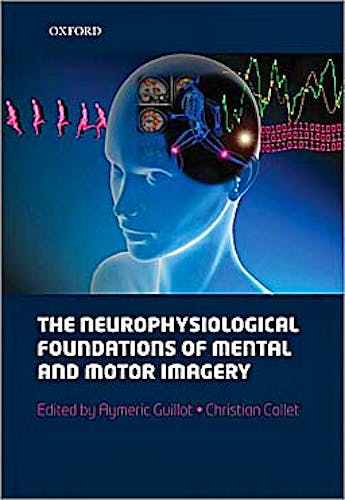

No hay productos en el carrito



The Neurophysiological Foundations of Mental and Motor Imagery
Guillot, A. — Collet, C.
1ª Edición Enero 2010
Inglés
Tapa dura
296 pags
706 gr
18 x 26 x 2 cm
ISBN 9780199546251
Editorial OXFORD
LIBRO IMPRESO
-5%
123,25 €117,09 €IVA incluido
118,51 €112,59 €IVA no incluido
Recíbelo en un plazo de
2 - 3 semanas
About this Book
- Include contributions from the most famous researchers in the field of imagery research, providing the reader with an integrative and complementary viewpoint of the imagery experience
- Covers the different applications of imagery in learning, training and clinical rehabilitation, providing a guiding framework for imagery studies and assisting the reader in developing more effective imagery interventions
- Contains practical applications as well as theoretical approaches, helping the reader to fully understand and appreciate the imagery process
- Provides a state of the art review of this field of research, providing in-depth reviews, meta-analyses, and research syntheses which will contribute to summarize our knowledge and spur new research
Mental imagery is the ability to form perceptual-like representations of objects
or events on the basis of information stored in memory. Motor imagery is often
used when the human body is involved, where subjects imagine the body moving
or manipulating objects. The use of mental practice, including motor imagery
for the rehabilitation of patients with cerebral motor impairments, is one of
the most active areas in the field of motor imagery research. Such data provide
evidence for imagery as a method in stroke rehabilitation, leading to reliable
reconstruction of neural networks and thus to functional recovery.
In recent years, our understanding of imagery has advanced greatly thanks to
functional imaging studies using, for example, PET and fMRI. There is now ample
evidence that a common neural substrate (albeit not identical) underlies mental
imagery and visual perception, on the one hand, and motor performance and motor
imagery, on the other.
This book, the first of its kind, examines three main aspects of mental imagery. In the first part, the chapters address the neural basis of mental and motor imagery, the relationships between mental imagery and perception, and between motor imagery and physical execution. In the second part, the chapters focus on the evaluation of mental/motor imagery accuracy, including both central and peripheral nervous system recordings. The final chapters address the effects of mental practice on motor recovery after stroke.
Providing a state of the art review along with in-depth summaries, meta-analyses, and research syntheses, this book will be important for those in the fields of cognitive neuroscience, physiology, and rehabilitation.
Readership: Neuroscientists and cognitive neuroscientists; neurologists; rehabilitation
specialists
Table of Contents
Marc Jeannerod: Preface
Introduction
SECTION 1: The neural substrates of mental and motor imagery
Stephen M. Kosslyn, Giorgio Ganis and William L. Thompson: Multimodal Images
in the Brain
Poirel N., Zago L., Petit L. and Mellet E.: Neural bases of topographical representation
in humans: Contribution of neuroimaging studies
M. Lotze and K. Zentgraf: Contribution of the primary motor cortex to motor
imagery
Cathy M Stinear: Corticospinal facilitation during motor imagery
SECTION 2: Neurophysiological correlates of motor imagery
Christa Neuper & Gert Pfurtscheller: EEG Characteristics during Motor Imagery
Aymeric Guillot, Florent Lebon and Christian Collet: Electromyographic activity
during motor imagery
C Collet and A Guillot: Autonomic nervous system activities during imagined
movements
Aymeric Guillot, Magali Louis, and Christian Collet: Neurophysiological substrates
of motor imagery ability
SECTION 3: Motor imagery in rehabilitation
H.C. Dijkerman, M. Ietswaart and M. Johnston: Motor imagery and the rehabilitation
of movement disorders: an overview
S.J. Page: An overview of the effectiveness of motor imagery after stroke: A
neuroimaging approach
Francine Malouin, Carol L. Richards, Philip L. Jackson, Julien Doyon: Motor
imagery for optimising the reacquisition of locomotor skills after cerebral
damage
Dickstein R. and Tamir R.: Motor Imagery Practice in Individuals with Parkinson's
Disease
Luís Aureliano Imbiriba, Sylvia Joffily, Erika Carvalho Rodrigues, Claudia
D. Vargas.: Blindness and motor imagery
G. Pfurtscheller and C. Neuper: EEG-based brain-computer communication
SECTION 4: Motor imagery in learning processes
Aymeric Guillot, Ursula Debarnot, Magali Louis, Nady Hoyek, Christian Collet:
Motor imagery and motor performance: evidence from the sport science literature
Tadhg MacIntyre and Aidan Moran: Meta-imagery Processes Among Elite Sports Performers
R.E. Sapien and R.G. Rogers: The use of motor imagery in teaching surgical skills
lessons from sports training
Paul S.Holmes, Jennifer Cumming and Martin G. Edwards: Movement Imagery, Observation,
and Skill
Philip Jackson and Amélie M. Achim: From the mental representation of
pain and emotions to empathy
Author Information
Edited by Aymeric Guillot, Université Claude Bernard, Lyon, France, and Christian Collet, Université Claude Bernard, Lyon, France
Reviews
"This book provides an intriguing look at an oft-neglected area of mental imagery research. The theoretical and practical applications are well laid out and provide a balanced viewpoint on the cuurent state of the science in this field." - Christoper J. Graver, Doody's Notes
© 2026 Axón Librería S.L.
2.149.0